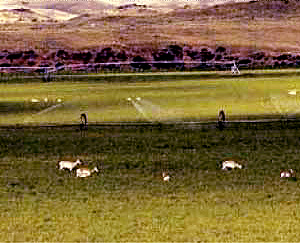 |
 |
RANGE Special Report:
|
 Pronghorn antelope graze in irrigated fields north of Buffalo, Wyo. When lands are cared for, everyone benefits, wildlife banquets. Photo © Cynthia Baldauf |
Ruminants (cattle, buffalo, deer, antelope, sheep, elk, etc.) need good grass. In one of those marvels of nature's harmony, they also create the conditions that allow good forage to flourish, even in dry and brittle environments. Once you understand how rest works, you can never look at a patch of ground in the same way again.
SPECIAL SECTION: The Value of Rest
- Confessions of an Environmentalist
- A Fence on the Border
- A Walk in the Grass
- Beware of Rest
- Tall Grass Prairie
- From the Ground Up
- 50 Years of History
- Rest-Rotation, Recovery
- With & Without Grazing
- Ranching & Research
- What do you want this land to be?
- Owens Creek/West Muddy Creek
- Gone To Weed
Download The Value of Rest (PDF, 1MB).
|
© 1998-2005 RANGE magazine. All rights reserved. | For reprints, permissions or general questions, contact RANGE |
|
Brought to you by RANGE magazine |